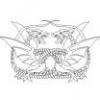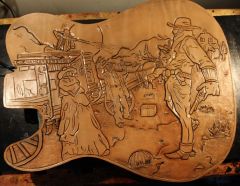I find it very interesting that some folks have issues with Oil dyes. To date I have had no issues with rub off (except with USMC Black) and I use it exclusively on my tank bibs - I go through at least one 32 oz. bottle a month. Some of those are very large pieces that I expect folks to rub against quite a bit so rub off is a huge concern.
First a few questions - are you using the dye from the 4oz or larger bottles? Did the bottle look newish (no dust, etc) in the store when purchased? How long has it sat around the shop? Did you use a deglazer or at least clean the piece with alcohol prior to dying?
I have found that Pro Oil dye acts a little differently than the others when it gets old. The carrier medium stays liquid, unlike the others that simply evaporate, but gets thicker as time goes on after opening the bottle. Left long enough, it turns the consistency of mud before it even starts to dry out. What this means to the end user is more pigment - less carrier and thus less penetration & more rub off.
Now, if it still looks 100% good and flows like water then it may be the application method. Of all methods to apply dyes, I have found the good 'ol trimmed wool scrap to work the best. Paint brushes, daubers and rags tend to apply a thinner top coating layer whereas the wool scrap unloads the dye very well as soon as it hits the leather (or your hands, clothes, etc). Saturate the wool scrap, rub on in a circular motion, overlapping the last areas dyed by 50% or so. Let sit for 10-15 minutes and apply a second coat in the same manner. The piece will feel pretty 'wet' and soft. After the second application, I use the unloaded wool scrap to 'massage' the leather and remove any extra pigment. Seems odd to use a wool scrap previous loaded with dye to remove pigment but it works. Now, without letting it dry completely, apply a generous coat of Neatsfoot Oil using a new cloth (I like diaper cloth or automotive polishing rags for this) and saturate the piece using the same overlapping circular motion. Let sit overnight. When you come back to the piece, use a fresh rag and buff the surface, medium pressure in the same overlapping, circular motion. There should be very little rub off at this point. Apply a good finish like Resolene, Saddle-Lac, etc. (matte or satin finishes are also fine like Bag-Kote, etc) per the instructions, let dry. Last step, apply a good leather dressing like Pecard's and rub in well & buff to finish.
Personally, I'm not fond of the just oil & beeswax finish on a heavily dyed piece. Wax never truly dries and wears off easily. On hot days it can reliquify easily and if it's absorbed enough of the dye during application, the rub off/buffing of the wax will come off tinted. Heavily dyed pieces that are intended to be handled or come into contact with often should have some kind of a sealing top coat, but that's my opinion.
That's my process, other will undoubtly differ so take it with a grain of salt.
Cheers,
Chris










